The physical and chemical status of a pharmaceutical formulation influences the type and extent of microbial spoilage considerably. A specific combination of conditions within a product may favor its degradation by a particular group of microorganisms.
Factors Affecting Microbial Spoilage
(i) Size of innoculum: Low levels of contaminants may be present in a product but it would cause low rates of deterioration. Ingredients contaminated by a high level of microorganisms cause appreciable microbial degradation. However, innoculum size alone is not always a reliable indicator of likely spoilage potential. A very low level of Pseudomonas in a weakly preserved solution may suggest a greater risk than tablets containing high numbers of fungal and bacterial spores.
(ii) Nutritional factors: Gross microbial spoilage of a pharmaceutical product generally requires appreciable growth of the contaminating microorganisms within the dosage forms. Most of the organic and inorganic ingredients act as potential carbon or nitrogen substrates for microbial growth. The complexity of many formulations offers considerable nutritional variety for a wide range of microorganisms. The use of crude vegetable or animal products in a formulation provides an additionally nutritious environment. Demineralized water (prepared by ion exchange) contains sufficient nutrients to allow the multiplication of water-borne Gram-negative bacteria.
(iii) Moisture content: Dissolved components of an aqueous formulation may form a complex with water molecules via hydrogen and other bonding thus lowering the proportion of the water available to contaminant microorganisms in the product. The high concentration of the solute in the formulation indicates that water activity (Aw) is low. Most microorganisms grow best at high water activity. Hence, formulations can be protected from microbial attack by lowering their water activity with the addition of suitable levels of sugars, polyethylene glycols, or sodium chloride or by drying.
Condensed moisture films can form on the surface of tablets or bulk oils as a result of fluctuations in storage temperatures and the moisture content of the air may be sufficient to initiate fungal growth. Moisture films similarly formed on the surface of viscous syrups permit yeast and fungal growth.
(iv) Temperature: Spoilage of pharmaceuticals could occur over the range of about – 10 to 60 oC, although it is much less likely at the extremes. Storage within specific, narrower, temperature ranges will encourage the growth of particular groups of spoilage organisms. Syrups and multidose eye drop preparations are sometimes dispersed with the label ‘store in a cool place’, to reduce the risk of in-use contamination before the expiry date. It is recommended that distilled water for the preparation of ‘water for injections’ be stored at 80 oC before sterilization, to prevent pyrogen production.
(v) pH: Extremes of pH prevent a microbial attack, although the growth of mold is commonly observed in solutions of dilute hydrochloric acid. Antacid mixtures, mouth washes, and distilled water show growth of Pseudomonas species and other Gram-negative bacteria at neutral pH. Soap emulsions (pH 8.0 – 9.5) and mixtures of magnesium hydroxide or aluminum hydroxide gel discourage microbial attack. Acidic conditions favor fungal and yeast proliferation and inadequately preserved flavored pharmaceutical products at pH 3.5 can support the growth of microbes. Yeasts can metabolize organic acids raising the pH sufficiently to allow a secondary bacterial attack.
(vi) Redox potential: The ability of microbes to grow in an environment is influenced by its oxidation–reduction balance (redox potential). Vacuum packing of foodstuffs or the inclusion of oxygen absorbers in the package to minimize oxygen levels and reduce microbial spoilage. Oxygen removal to control spoilage in medicines is not a practical proposition although it is used to control non-biological oxidation. The redox potential even in fairly viscous emulsions may be quite high due to the appreciable solubility of oxygen in most fats and oils.
(vii) Protective components: Various components of formulations and products may increase the resistance and longevity of contaminant microorganisms. Microbes can show more resistance to heat or desiccation in the presence of some polymers such as starch, acacia, or gelatin. Adsorption of microorganisms onto suspended particles such as kaolin, magnesium trisilicate, or aluminum hydroxide gel may increase their longevity. Some substances such as surfactants, suspending agents, and proteins can increase the resistance of micro-organisms to preservatives.
Make sure you also check our other amazing Article on : Testing of Clean and Aseptic Rooms
